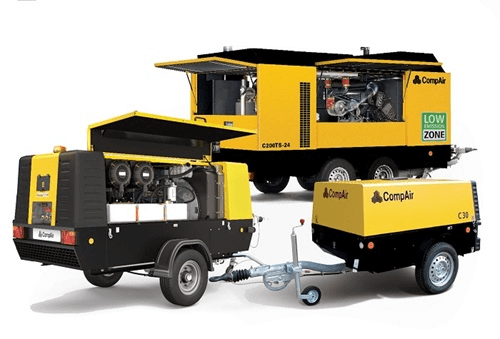Reciprocating air compressors are also called piston compressors because they use pistons driven by a crankshaft to compress air. The simplest type is a single-stage air compressor. This type of compressor works simply by drawing ambient air into its inlet, pumps the sifted air through the pistons for compression, and then sends the pressurized air into the chamber or tank for storage. It compresses air in a single piston stroke. When you increase the number of cylinder stages, the compressor can operate several tools simultaneously.
All types of air compressors, both single and two-stage, function for the same purpose of increasing pressure and reducing the volume of gas. Both single and two-stage air compressors have two cylinders for easy balance of air. The difference is that in the two-stage air compressors the air gets compressed twice, which is why it is also called a dual-stage compressor. In a dual-stage compressor, ambient air is initially compressed through a large piston at low pressure. The compressed air then goes through a cooling process through a heat exchanger. This cooling process reduces the amount of work on the second compression. After pressurized air cooled down, it goes for a second compression through a smaller piston under higher pressure. After the pressurized air gets its second stage of compression, it is delivered and stored in a holding chamber for storage until use. Double compression produces double energy and higher air power, which is very useful for large scale operations that use complex pneumatic types of machinery, and for operations that need a continuous supply of pressurized air.
Two-stage reciprocating air compressors are pricey compared with single-stage air compressors. But your purchase should not be based on the price. Many factors need to be considered. If you use the right compressor for the right application, even a two-stage compressor will give you cost savings.
Here is a shortlist of applications of two-stage reciprocating air compressors:
- Bottling line
- Auto assembly line
- Glass production
- Food packaging and preparation line
- Dairy farms
- Gas stations
- Textile
- Plastic industries
- Aerospace
- Passenger and military aircraft
In general, these are the basic guidelines to remember in choosing a two-stage compressor:
- Pressure requirement
Operations that need higher pressure should get a two-stage compressor. This means, operations requiring more than 100PSI should use two-stage compressors for efficiency. Remember, double pressure means double power.
Your trusted air management company will help you correctly determine the total CFM requirements for your operations.
2. Temperature requirement
Since output air is relatively cooler because of the heat exchanger process, this compressor is critical for pneumatic tools that can be damaged by heat.
3. Volume requirement
Since a multi-stage compressor produces more volume per cycle, it improves productivity for operators. This becomes important for operations that run their tools and machinery continuously.
Learn more about single-stage and two-stage reciprocating air compressors, and allow us to help you identify the best option for your needs. Visit us or call us today for an appointment.



